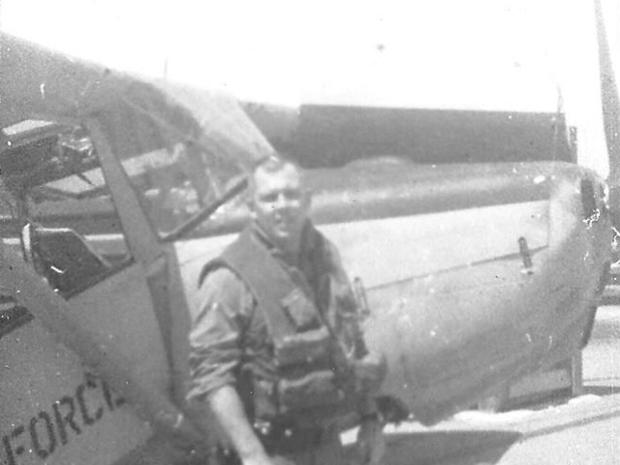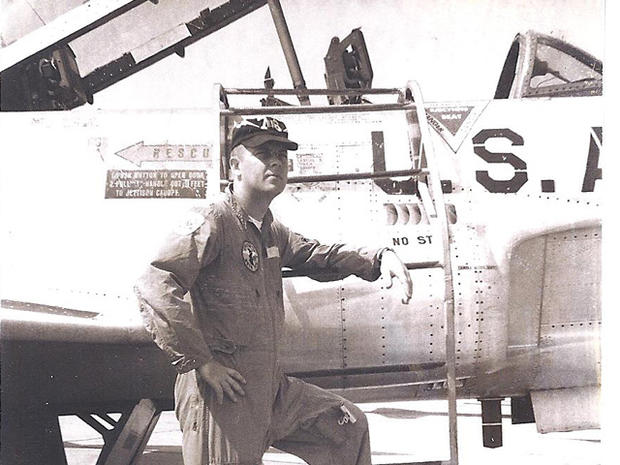Fighting in South Vietnam -- in a Cessna
Thomas Patrick Laffey flew a "Bird Dog" in Vietnam, a Cessna 0-1 that was famously low and slow. Laffey's weapon was his AR-15 rifle, which he shot out the window. He didn't even carry a parachute.
"If we did get hit in the engine or anything like that, we would have to take the airplane down and try to find a safe place to land," he said.
He was a forward air controller, whose job it was to try to make sure that bombs or napalm did not land on civilians or on American or South Vietnamese troops. He was in charge of clearing all targets, directing the fighters in with white phosphorus rockets, he said.
It was dangerous job, especially over the Mekong Delta, where there was little cover.
"Of course, the bad guys knew that if they shot us down, then the fighters couldn't release anything because there was no one there to clear them in," he said.
One of the most famous cases of what could go wrong came in 1972, when a South Vietnamese plane mistook a group for North Vietnamese soldiers and dropped napalm on the village of Trang Bang. Associated Press photographer Nick Ut captured the enduring image of 9-year-old Kim Phuc running from the attack, naked because her clothes had been burned off.
Laffey, known as Pat, joined the Air Force in Milwaukee when he was 18. He wanted to fly.
His son Joseph remembers moving in with his grandparents in Boston when his father left for Vietnam because the family thought he had only about a 50 percent chance of returning.
But Pat Laffey, now 78 and living in Florida, a retired pilot from the former Continental Airlines, not only survived his year as a forward air controller, but returned to Vietnam to fly a KC-135 refueling airplane.
"You train to do one thing and that's to fight," he said. "And lo and behold, you're fighting."
He was awarded the Distinguished Flying Cross for that first year, August 1968 until August 1969.
"During this period Major Laffey flew extremely hazardous missions through adverse weather conditions and through the constant threat of hostile ground fire and attack," the citation reads.
Most of the targets in the Mekong Delta were bunkers, complexes made of straw and mud from which the Viet Cong could fight, he said. But unless the bunkers took a direct hit, they were difficult to damage, he said.
Laffey, who worked with the Army's 9th Infantry Division, remembered one nightlong battle against what turned out to be a particularly large bunker. He had called for airstrikes, but planes weren't available, and so one of the Army companies moved in and then another. As he followed the soldiers, they were hit hard by gunfire. A helicopter was shot, wounding the soldiers inside. Another crashed, killing everyone aboard.
"So I was up in the air, trying to tell some people where they are, talking to the ground, talking to the ground and so finally I'm running out of fuel," he said.
Finally he got the airstrikes he had been asking for and 138 of the enemy were killed. Others were wounded but escaped, with bloody trails leading away from the bunker.
When he got back to the support base, soldiers thanked him. He said he got some satisfaction knowing he had done something to help keep them alive, even if he was counting the days when it would come to an end.
"How those guys could hack it on the ground I don't know," he said.
Laffey was comfortable in his cockpit. In the air, he was the eyes for the Army, and with his binoculars, he could see what had changed on the ground. When he was fired on, he mostly did not know until the men below told him, he said. It was too loud in the plane.
Laffey said the most difficult job, the most gut-wrenching, was trying to coordinate an airstrike at night with troops in close contact with the enemy. He would be looking for the target, checking in with the fighters and the planes that were dropping flares.
"And then you would talk to the ground -- 'Give me an ID' -- they would flash these lights at you and then you'd pretty well find out where they are by saying 'Stop, go,' because the enemy was listening of course, and then you'd say, 'Well I hope I got all my stuff together,'" he said.


